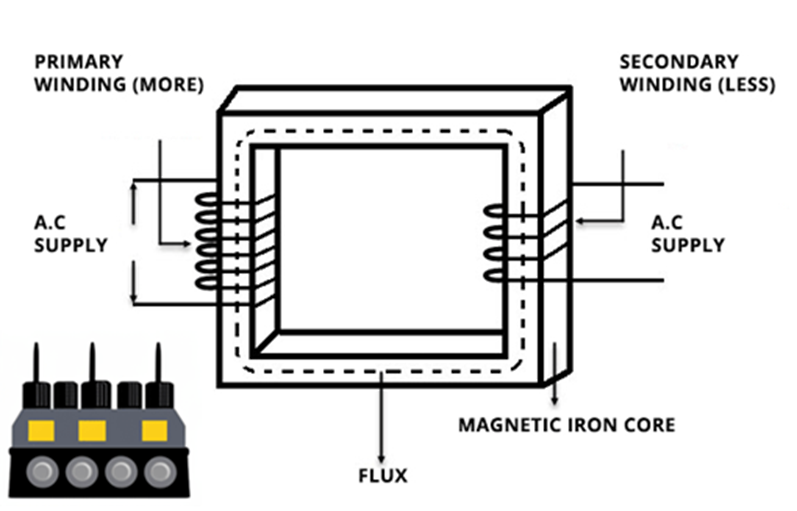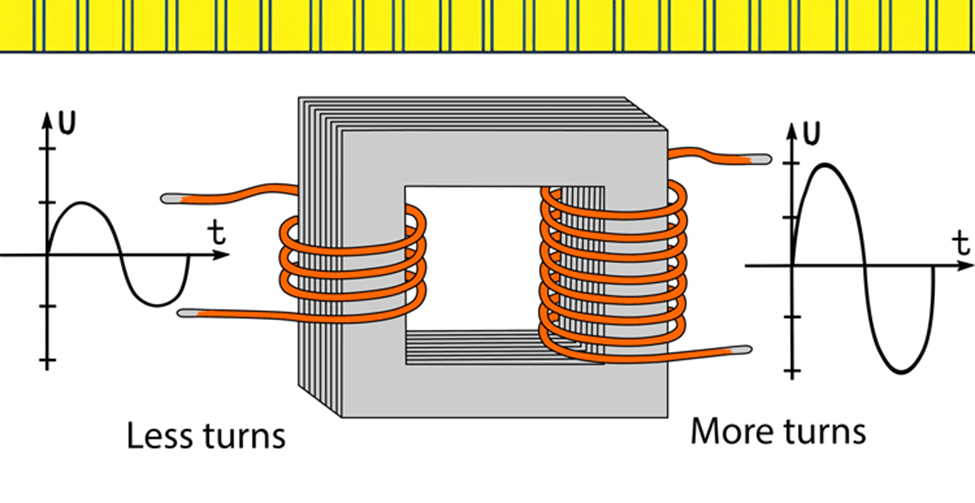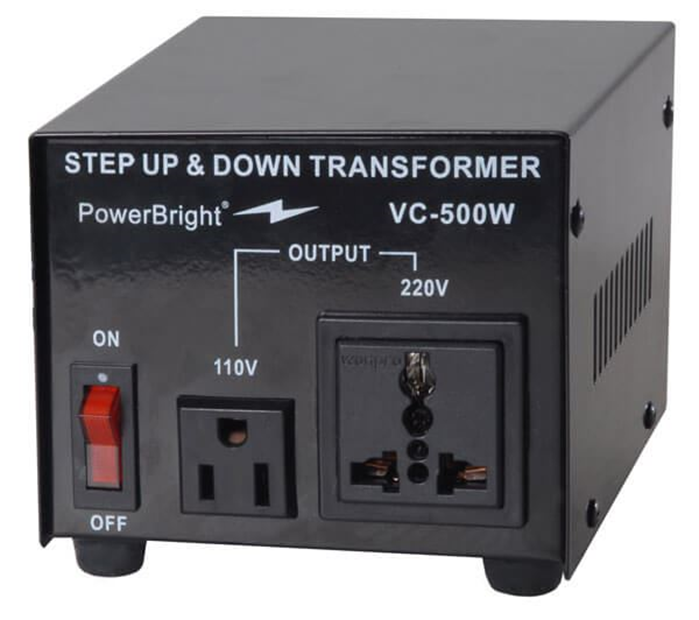This website uses cookies so that we can provide you with the best user experience possible. Cookie information is stored in your browser and performs functions such as recognising you when you return to our website and helping our team to understand which sections of the website you find most interesting and useful.
What is a Step-Down Transformer?
29/07/2023, hardwarebee
A step-down transformer is a kind of electrical transformer that changes the voltage at the secondary winding from the primary winding, which is greater, to the secondary winding, which is lower. The voltage from input to output is reduced because of having more turns in the main coil than in the secondary coil.
Faraday’s law of electromagnetic induction is the foundation of a transformer’s fundamental operating system. Alternating current (AC) flows through the primary coil, modifying the magnetic field that surrounds it. A voltage in the secondary coil is produced by the fluctuating magnetic field and is inversely proportional to the secondary winding’s number of turns. The voltage transformation ratio is determined by the turns-per-inch ratio of the primary and secondary coils.
In electrical power distribution networks, step-down transformers are frequently used to convert the high voltage produced by power plants to a lower voltage suited for home or industrial usage. This lower voltage is safer and more practical for domestic appliances and electrical equipment.
For instance, depending on the location, the typical home voltage in various nations is either 110–120 volts (V) or 22–240 V. However, far greater voltages, such as 11,000 V, 22,000 V, or even more, may be included in the electricity delivered from the power plants. Substations employ step-down transformers to reduce the voltage to a suitable level for domestic usage.

Pros and cons of using a Step-Down Transformer
A step-down transformer has advantages and disadvantages, depending on the specific application and requirements. Let us look at the pros and cons:
Pros of using a step-down transformer:
1. Voltage Regulation: Step-down transformers enable the regulation and lowering of voltage to a desired level, guaranteeing a steady and suitable voltage for various electrical equipment and appliances.
2. Safety: Because greater voltages can be hazardous and even fatal, lowering the voltage with a step-down transformer is essential for assuring user safety.
Power Distribution: Step-down transformers are essential for energy distribution networks because they allow for the efficient and loss-free transmission of power over long distances.
Efficiency: When voltage is lowered, the current increases proportionally, but overall power remains constant (ignoring losses). This means that lower currents can be used for the same amount of power, reducing resistive losses in transmission lines.
Compatibility: Many electrical devices and appliances are designed to work with specific voltage levels, and step-down transformers make it possible to use devices from different regions or countries with different voltage standards.
Cons of using a step-down transformer:
- Energy Losses: No transformer is 100% efficient, so some energy is lost during the voltage transformation process. These losses can be in the form of heat and reduce overall energy efficiency.
- Size and Weight: Step-down transformers can be relatively large and heavy, especially for higher-power applications. This can be a limitation in some installations where space is a concern.
- Cost: Depending on the power rating and construction, step-down transformers can be expensive, particularly for high-power applications.
- Voltage Fluctuations: In some cases, step-down transformers may not provide perfectly regulated output voltage, leading to fluctuations and possible issues with sensitive equipment.
- Electrical Noise: Transformers can generate electrical noise or electromagnetic interference, which might affect nearby electronic devices if not adequately shielded.
Step Down Transformer Applications and Usage
Step-down transformers find various applications and usages in electrical systems and industries due to their ability to convert high voltages to lower voltages. Some of the most common applications and usages of step-down transformers include:
- Power Distribution: In electrical power distribution systems, step-down transformers are used at substations to lower the high voltage generated at power plants to safer and more usable levels for residential, commercial, and industrial consumers.
- Household Electricity: Step-down transformers are widely used to provide the standard voltage levels required for residential buildings. In many countries, the typical household voltage is 110-120 volts or 220-240 volts, depending on the region.
- Industrial applications: Different industrial machinery and processes require different voltage levels. To adjust the voltage to the requirements of various industrial machines, step-down transformers are employed, lowering the possibility of damage and assuring correct operation.
- Electronic gadgets: For safe and effective functioning, many electronic gadgets, including computers, cellphones, and chargers, need lower voltages. Power adapters and chargers employ step-down transformers to deliver the proper voltage levels.
- Low-Voltage Lighting: Step-down transformers are frequently used in low-voltage lighting systems, including halogen and LED lighting, where the main power supply must be decreased to the voltage needed by the lighting fixtures.
- Audio Equipment: Some audio equipment, like guitar amplifiers and audio mixers, may require lower voltages for specific components. Step-down transformers are used to provide the necessary voltage levels for these devices.
- Isolation Transformers: In some applications, step-down transformers are also used as isolation transformers to provide electrical isolation between the input and output circuits, preventing potential hazards like ground loops and protecting sensitive equipment.
- Renewable Energy Systems: In solar and wind power systems, step-down transformers convert the higher voltage generated by solar panels or wind turbines to a voltage suitable for grid connection or local distribution.
- Transportation: In electric trains and electric trolleybuses, step-down transformers are used to lower the voltage from overhead power lines to the appropriate levels for powering the onboard electrical systems.
- Control Circuits: Step-down transformers are used in control circuits of machinery and equipment to provide the necessary power for control components and sensors.
How does a Step-Down Transformer Work?
Step-down transformers operate on the Faraday-based electromagnetic induction concept. A shifting magnetic field is created around the transformer’s primary coil, or the input coil, as an alternating current (AC) passes through it. The secondary coil (the output coil) will then experience a voltage that is proportionate to the secondary winding’s number of turns because of this shifting magnetic field.
The primary and secondary coils, typically twisted around a common iron core, are the main parts of a step-down transformer. The transformer is more effective because the iron core improves the magnetic coupling between the coils.
An explanation of a step-down transformer’s operation is provided below:
- Primary Coil: The primary coil creates an alternating magnetic field when an alternating voltage is given to it.
- Induced Voltage: Through mutual induction, the main coil’s fluctuating magnetic field causes an alternating voltage in the secondary coil. The turn ratio between the main and secondary coils determines the intensity of the induced voltage.
- Turns Ratio: The number of turns in the primary coil (Np) divided by the number of turns in the secondary coil (Ns) is known as the turn ratio. The primary coil has more turns than the secondary coil in a step-down transformer because Np is greater than Ns.
- Voltage Transformation: The induced voltage in the secondary coil is lower than the input voltage because of the turn ratio. The relationship between the input voltage (Vp) and the output voltage (Vs) is given by the turns ratio:
Vs = Vp * (Ns / Np)
Where:
Vs = Output voltage (secondary voltage)
Vp = Input voltage (primary voltage)
Ns = Number of turns in the secondary coil
Np = Number of turns in the primary coil
- Current Transformation: The current in the primary and secondary coils is inversely proportional to the turn ratio. If the voltage is stepped down, the current is stepped up, and vice versa. This relationship maintains the conservation of energy, neglecting losses.
- Connection to the Load: The secondary coil is linked to any equipment or electrical devices that need a lower voltage to function properly.
- Power Transfer: The step-down transformer effectively moves electrical power from the main circuit, which has a higher voltage and lower current, to the secondary circuit, which has a lower voltage and greater current, while preserving total power (against losses).
Step-down transformers make it possible to distribute electrical power safely and effectively at lower voltages for various residential, commercial, and industrial uses by modifying the turn ratio and the transformer’s architecture.

Step-down Transformer Cost
The cost of a step-down transformer can vary significantly depending on several factors, including the transformer’s power rating (measured in volt-amperes or kilovolt-amperes), the voltage transformation ratio, the quality and design of the transformer, the manufacturer, and the region or country where it is purchased. Other factors that can influence the cost include the type of core material used (e.g., silicon steel or amorphous metal), the level of insulation and safety features, and any additional customizations required for specific applications.

An approximate range for the price of smaller step-down transformers used in electronics and home appliances is $20 to $100. Usually accessible as commercial off-the-shelf devices, these transformers are less powerful and easier to find.
The price of bigger step-down transformers, on the other hand, utilized in industrial applications or power distribution systems, can range from a few thousand dollars to tens of thousands of dollars or more. High-power transformers, such as those used in electrical substations, may be quite expensive due to their size, complexity, and need for customization.
Transformers made specifically for a customer’s use or those with unique characteristics, such as isolation transformers or transformers created to meet a particular voltage and frequency standard, may also be more expensive.
It is crucial to remember that a transformer’s price should be balanced with its quality and effectiveness. Cheaper transformers could not be as efficient, which would result in more energy losses and higher operating expenses over time. Due to lower energy use and maintenance costs, purchasing a higher-quality transformer can become more affordable in the long term.
It is advisable to connect with reliable transformer manufacturers or suppliers and supply them with the necessary parameters for your application to receive an exact cost estimate for a specific step-down transformer. They can provide a thorough price depending on your requirements and preferences.










